MXA RACE TEST: THE REAL TEST OF THE 2022 SUZUKI RM-Z450
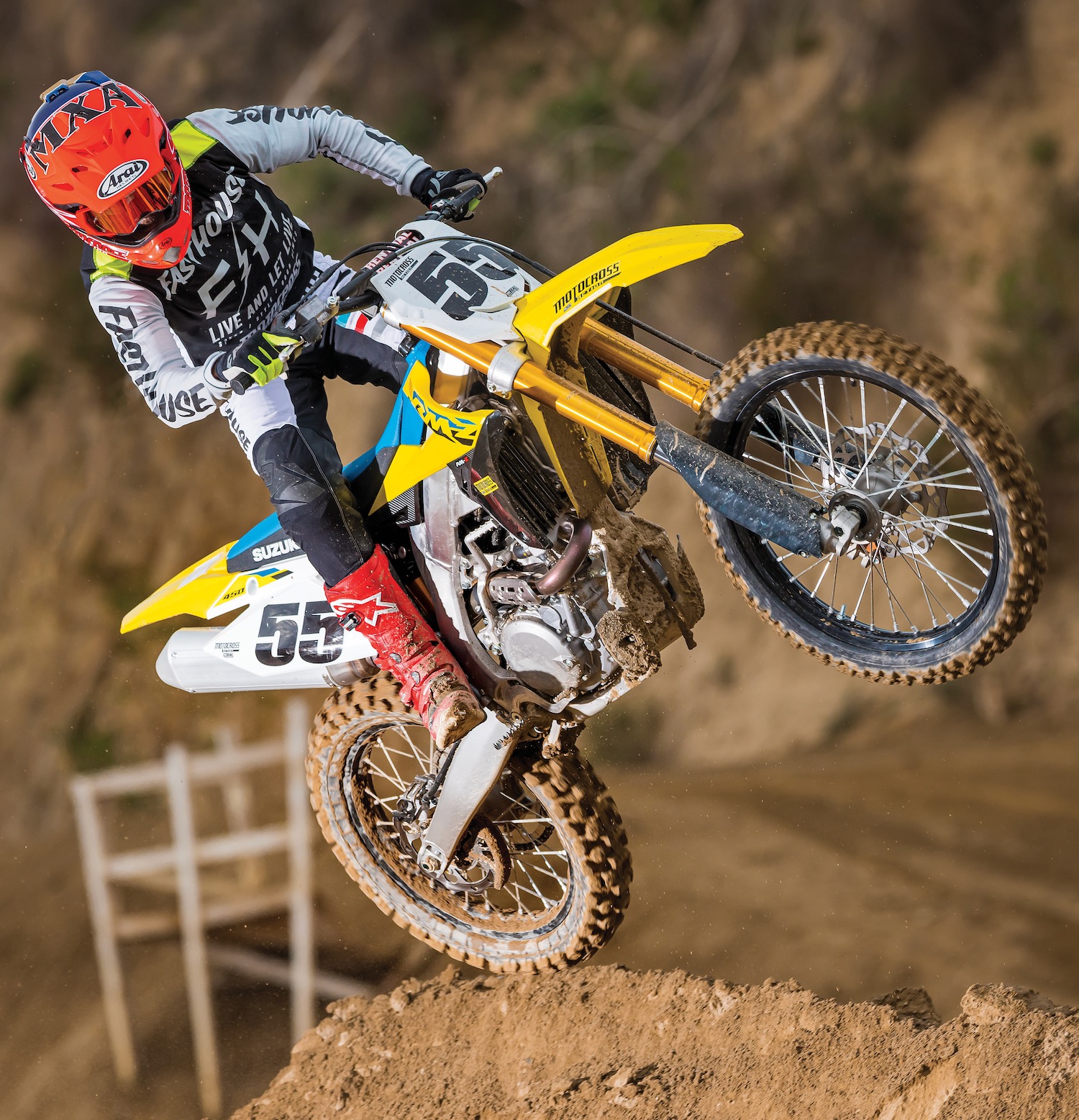 THE GEAR: Jersey: Fasthouse Clyde, Pants: Fasthouse Raven 2.0, Helmet: Arai VX-Pro4, Goggles: EKS Brand Lucid, Boots: Alpinestars Tech 7.
THE GEAR: Jersey: Fasthouse Clyde, Pants: Fasthouse Raven 2.0, Helmet: Arai VX-Pro4, Goggles: EKS Brand Lucid, Boots: Alpinestars Tech 7.
Q: FIRST AND FOREMOST, IS THE 2022 SUZUKI RM-Z450 BETTER THAN THE 2021 RM-Z450?
A: Just so you know, the 2022 RM-Z450 package was first introduced in 2018, received a minor shock spring update in 2019 (from a 56 N/mm spring to a 54 N/mm spring) and was untouched in 2020, 2021 and 2022.
Q: HOW DOES THE 2022 SUZUKI RM-Z450 RUN ON THE TRACK?
A: It bears repeating, and we have said this many times in previous RM-Z450 tests, that for the average Novice, Vet or play rider, the existing RM-Z450’s power is located in the perfect spot on the rpm curve to get the job done; however, if you are a wanna-be Pro or a high-rpm revver, you will not like the RM-Z450 powerband because it gives up too much horsepower on top. You can’t rev the Suzuki RM-Z450 because it doesn’t want to be wrung out.
It is not our intention to make the 2022 Suzuki RM-Z450 engine appear to be a lost cause, because when short-shifted, kept in the meat of the powerband and used properly, it has a very usable, pleasant and effective 450cc powerband. It is brisk off the bottom and strongest from 7000 to 8700 rpm (where the acceleration is generated). There is nothing wrong with a low-to-mid powerband on a 450cc motocross bike, but if you’re looking for top-end power, lots of over-rev and maximum peak horsepower, yellow will not be your color.
Q: HOW DOES THE 2022 SUZUKI RM-Z450 RUN ON THE DYNO?
A: On the dyno, the red, green, blue and white competition pump out around 60 horsepower in stock trim, while the RM-Z450’s 54.4 horsepower is way behind the curve. That missing 4 horsepower will be a liability on a long start, steep uphills, deep sand or a drag race from corner to corner.
At 7000 rpm, the Suzuki is at its best. It makes 45.9 horsepower at 7000 grand. At 8000 rpm, the RM-Z makes 52.4 horsepower (while narrowing the gap with the rest of the pack to a reasonable 2-horsepower deficit). From 9000 rpm on up, the picture is bleak. The RM-Z450 peaks at 54.39 horsepower at 8800 rpm—that is very low on the powerband when compared to the YZ450F’s 58.56 horsepower at 9700 rpm. After 8800 rpm, the Suzuki is dead in the water. Need proof? By 11,000 rpm, the 2022 Suzuki RM-Z450 makes 7.69 horsepower less than the 2022 YZ450F.
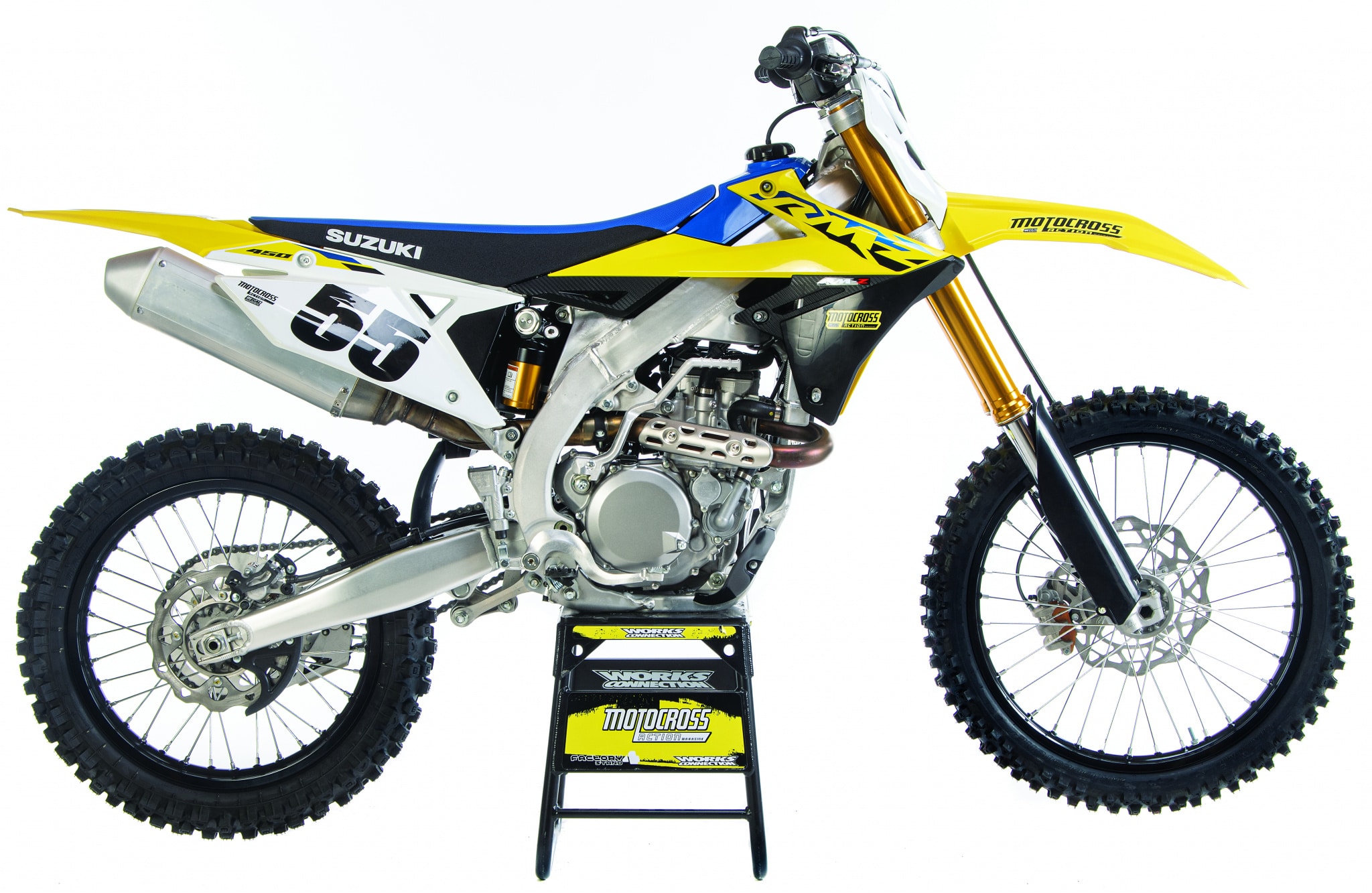 The Suzuki RM-Z450 has suffered from benign neglect for years. It will take a tremendous R&D effort, not to mention millions of dollars, to turn the RM-Z450 into a lightweight, 58-horsepower, well-suspended, electric-start, 2023 motocross bike.
The Suzuki RM-Z450 has suffered from benign neglect for years. It will take a tremendous R&D effort, not to mention millions of dollars, to turn the RM-Z450 into a lightweight, 58-horsepower, well-suspended, electric-start, 2023 motocross bike.
Q: WHAT ARE THE BEST ASPECTS OF THE 2022 RM-Z450?
A: Here is a quick list of where the 2022 RM-Z450 shines.
(1) Powerband. Every test rider loved the powerband because, in the middle of a long moto, when the bumps and jumps are working your body over, the clean bottom and nice midrange are rider friendly.
(2) Tunablity. The 2022 RM-Z comes with three plug-in maps: stock (white), aggressive (white) and mellow (grey). Most test riders preferred the stock plug-in for general racing. Even more impressive is that Suzuki has joined Yamaha in the “Smart Phone Tuning Club” with its GET-developed MX-Tuner 2.0 app for Apple and Android phones. The app comes with four pre-programmed maps (aggressive, smooth, rich and lean), and you can make your own custom maps by changing the numbers in the 36 available boxes. You have to plug the MX-Tuner 2.0 connector into the RM-Z’s data cable to upload your selected or custom maps into one of the three Suzuki couplers, and you need to connect a separate 12-volt battery into the RM-Z450’s battery connector to provide power.
(3) Cornering. Even though we think that several competing 2022 motocross brands have stolen Suzuki’s thunder when it comes to sharp, accurate and agile cornering, the RM-Z450 is still a player when it comes to railing tight inside lines.
(4) Ergos. The bodywork is narrower. The bar bend is comfortable, and everything falls at hand easily; however, the stinkbug chassis setup takes away from all of the good things, which is why fixing the chassis’ balance should be your first priority.
(5) Color. The yellow plastic is a thing of beauty in motion. It looks clean, even when it’s dirty.
(6) Price. The 2022 MXA 450 shootout-winning Husqvarna FC450 retails for $10,399. By comparison, the 2022 Suzuki RM-Z450 retails for $8999—that is $1400 cheaper than the high-priced spread. The 2022 Suzuki is a bargain. Or is it?
Q: COULD YOU CLOSE THE GAP WITHOUT SPENDING MORE THAN $1400?
A: Because they have $1400 to play with, the Suzuki loyalists always claim that they could buy the Suzuki and, with the money they saved, make it as good as the KTM, Honda, GasGas, Yamaha, Husky or Kawasaki. Is that true? Let’s put it to the test. An FMF factory 4.1 exhaust system costs $900. It would get you a couple horses closer to the big guns. Plus, the lighter exhaust system would also knock enough weight off the RM-Z to get it to weigh the same 238 pounds as the YZ450F. The kicker? The FMF pipe alone would raise the 2022 RM-Z450’s all-in cost to $9899. Believe it or not, for that money you could have bought a 2022 GasGas MC450F, Kawasaki KX450F or Yamaha YZ450F (and had enough money left over to buy new gear). The popular FMF aftermarket pipe purchase may make your 2022 Suzuki RM-Z450 a little more powerful and a little lighter, but it will still be 16 pounds heavier than a GasGas MC 450F and 2.5 horses down to the Yamaha YZ450F.
The real-world value of a lower-cost machine is in leaving it alone and racing it as is. If you have to modify it, it won’t be a bargain anymore.
Q: WHAT DID THE MXA TEST RIDERS HATE ABOUT THE 2022 RM-Z450?
A: MXA’s job is to evaluate each machine thoroughly enough to separate the wheat from the chaff. Here is a list of the RM-Z450’s chaff.
(1) Resale value. The low MSRP and the willingness of Suzuki dealers to wheel-and-deal on the out-the-door price kills the resale value of used RM-Z450s. And it is from the sale of used bikes that a racer get a reasonable portion of the price of a new bike. If you can’t sell the old warhorse, you will have to reach deep to buy a new one.
(2) Starting. Not every bike made needs to be outfitted with electric starting, but if we had to pick one bike that needed it more than any other, it would be the Suzuki RM-Z450. Why? Because its kickstart lever is so high on the cases that short riders, riders with bad knees and weak riders can’t get a full kick.
(3) Clutch. None of the Japanese clutches are as good as the Belleville-washer clutches on the KTM, Husqvarna and GasGas. And, if we were ranking the four Japanese clutches, Suzuki’s clutch would come in last. If you can’t afford a $1200 Hinson or Rekluse clutch for your RM-Z450, invest in stiffer clutch springs.
(4) Weight. At 241 pounds before you put gas in the tank, the RM-Z450 is the heaviest bike on the track. You can feel it!
(5) Handling. You might think that the bike that turns in best would be considered the best handling bike on the track. Not so! The RM-Z450 is at its best at turn-in, but it suffers from serious instability issues at speed, which isn’t just confined to head shake.
(6) BFRC shock. The Showa BFRC rear shock moves too freely. The loose feeling produces different load characteristics from what motocross racers are used to. It doesn’t like to follow rough ground. In short, it is awesome as long as it never sees a bump. The easiest fix for Suzuki is to spec the conventional shock that comes on the RM-Z250
Q: WHAT ARE THE 10 MODS THAT THE MXA WRECKING CREW MADE TO THE 2022 RM-Z450?
A: These are the 10 mods that MXA made to the 2022 RM-Z450 and its 2020 and 2021 predecessors.
(1) Aftermarket exhaust system. Over the last eight years, the only RM-Z450 updates were launch and traction control in 2016. Because of the lack of ingenuity by Suzuki’s engine designers, the aftermarket exhaust pipe manufacturers have been able to fine tune their Suzuki pipes to the Nth degree. Whether it is Pro Circuit, FMF, HGS or Akrapovic, they can all lift the RM-Z450 power out of the doldrums.
(2) Gearing. We switch the stock 13/50 gearing for 13/51 sprockets. This allows us to use third gear sooner and get more drive out of tight turns to make up for the 4-horsepower hole that Suzuki put us in.
(3) High-pressure radiator cap. The stock 1.1 kg/cm2 RM-Z450 radiator cap allowed our RM-Z450’s coolant levels to drop during long motos. Twin Air and CV4 offer 1.8 kg/cm2 and 2.0 kg/cm2 radiator caps.
(4) Works Connection Elite clutch perch. With the stiffer clutch springs installed, the clutch pull was harder than stock. To cure this, we swapped the stock Suzuki clutch perch for a Works Connection Elite clutch perch assembly. If you have the money, a Hinson or Rekluse clutch is the ultimate fix.
(5) Heavy-duty clutch springs. Heavier springs improve clutch feel, increase bite on acceleration and increase the stock clutch plate life. We don’t always run all of the heavy-duty clutch springs; sometimes we find that three stiff springs can fine-tune the feel at the lever.
(6) FCP engine mounts. The turning characteristics of the RM-Z450 are second to none, but straight-line stability is less confidence-inspiring. The overly rigid chassis fights the ground instead of taming it. We ran FCP head stays and motor mounts to allow more flex and create a more forgiving ride.
(7) TM Designworks chain guide. The stock RM-Z450 chain guide wears out incredibly fast and will not only eat through the rubber buffer but the metal cage as well. We run a TM Designworks Factory Edition #1 chain guide. It lasts almost indefinitely.
(8) Shock linkage. We ran a longer Pro Circuit shock linkage than the stock 135mm link. The longer link lowered the rear of the Suzuki and stiffened the initial part of the shock stroke, which allowed us to have more options in compression, rebound settings, fork height and head angle.
(9) Balance. The whole chassis is out of balance. MXA’s goal on the 2022 Suzuki RM-Z450 was to get the rear end down and the front end up. This would kick the head angle out to slow down the steering input. An added benefit of a slacker head angle is that the 2022 RM-Z450 doesn’t head shake as much. We slid the forks down into the triple clamps. How far down? Flush would be about right. The longer link lowered the rear of the Suzuki and stiffened the initial part of the shock stroke, which allowed us to have more options for compression, rebound settings, fork height and head angle.
(10) Ekolu shock. We sent our BFRC shock to Brian Medeiros at Ekolu Suspension. Ekolu’s Brian Medeiros raced a Suzuki RM-Z450 in 2021 and used what he learned to set up a BFRC shock that was better balanced, squatted on corner entry, improved rear-wheel traction and didn’t step out when leaned into a bumpy corner. You can reach Brian at (951) 459-7993.
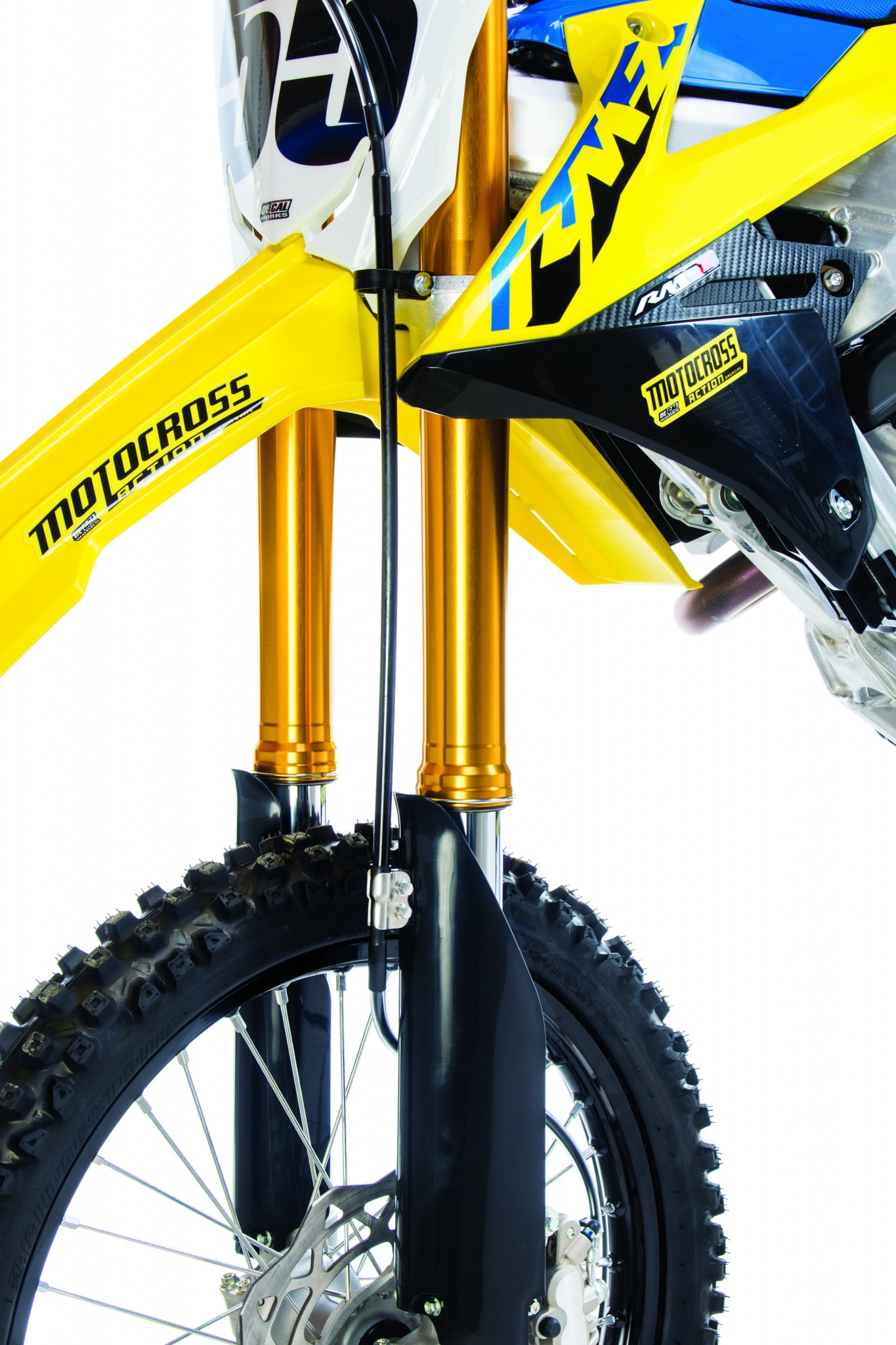 Suzuki, Kawasaki and Honda all share the same basic 49mm Showa fork. Suzuki’s setup is better than the ones on the KX450 or CRF450, but none are as good as Kayaba or WP.
Suzuki, Kawasaki and Honda all share the same basic 49mm Showa fork. Suzuki’s setup is better than the ones on the KX450 or CRF450, but none are as good as Kayaba or WP.
Q: WHAT DID WE HATE?
A: The hate list:
(1) Brakes. Suzuki has a 270mm rotor but did not put enough effort into the caliper design to help with modulation. It’s powerful but grabby.
(2) Kickstart. The lack of an electric starter isn’t the end of the world for the Suzuki RM-Z450, but it also isn’t on the cutting edge of motocross advancement, either.
(3) BNG. In years when a manufacturer doesn’t make any mechanical updates, it would be wise to put more than zero effort into the graphics.
Q: WHAT DID WE LIKE?
A: The like list:
(1) Cornering. The RM-Z450 is at its best on the entrance to turns. In its glory days, the Suzuki was the only bike that turned without effort—not so any more.
(2) Power. The 2022 RM-Z450 has a well-placed powerband. It doesn’t make much in the way of peak horsepower, but the power it makes is very usable.
(3) Traction control. The 2022 RM-Z450 features a traction-control system that continually measures throttle opening, engine speed and gear position to adjust the ignition timing and fuel-injector duration to stop wheelspin.
(4) Holeshot Assist. Suzuki’s Holeshot Assist Control (S-HAC) offers three mapping modes for different starting-line setups. We’d be happy with one launch control button that didn’t require us to read the owner’s manual to operate.
(5) Mapping. The GET-developed MX-Tuner 2.0 app allows you to remap the Suzuki RM-Z450 from your Apple or Android smartphone—once you jump through some hoops.
Q: WHAT DO WE REALLY THINK?
A: In a perfect world, the Suzuki world lose at least 10 pounds, add electric starting, get rid of the weird BFRC shock, design a totally new engine (not just because the current engine is the slowest in the class but because this powerplant has lost consumer confidence), build a clutch that maximizes power (instead of slip), and find engineers and test riders who prioritize balance over partial fixes. Suzuki has the know-how to build a world-beating RM-Z450, but Suzuki has spent the greater part of the last decade watching its competition pull away with new technology.
No one is deluded into believing that the 2022 Suzuki RM-Z450 is the best bike on the race track, but it offers a ridable, raceable and enjoyable bike for someone who wants to get in on the motocross experience without having to file for bankruptcy. As it sits, it is still the best bargain in motocross, but only if you get the suspension dialed in and leave everything else alone.
 The power profile of the RM-Z450 is unique in that it requires the rider to shift on the 8800-rpm bubble, but done right, it is very effective. Not Pro-effective, but acceptable for classes under Intermediate or over 30.
The power profile of the RM-Z450 is unique in that it requires the rider to shift on the 8800-rpm bubble, but done right, it is very effective. Not Pro-effective, but acceptable for classes under Intermediate or over 30.
MXA’S 2022 SUZUKI RM-Z450 SETUP SPECS:
This is how we set up our 2022 Suzuki RM-Z450 for racing. We offer it as a guide to help you get your own bike dialed in.
SHOWA COIL-SPRING FORK SETTINGS
After living through the SFF-TAC air fork years, every racer raves about coil-spring forks, but there isn’t a lot to rave about. Yes, they are better than SFF single-spring forks or the terrible SFF-TAC air forks, but that’s setting the bar pretty low. As with all of the late-model Showa coil spring forks, these forks are too soft for anything but lightweight riders. For hard-core racing, these are MXA’s recommended 2022 RM-Z450 fork settings (stock settings are in parentheses):
Spring rate: 0.50 N/mm
Compression: 10 clicks out (12 clicks out)
Rebound: 12 clicks out
Fork-leg height: Adjust it for the handling, not for the suspension.
Notes: We added 10cc of oil to both fork legs to stiffen the forks in the last 4 inches of travel to stop them from bottoming. This gave us more leeway in dialing in the compression. MXA test riders ran the compression from seven to 12 clicks out, depending on rider speed and track conditions.
SHOWA BFRC SHOCK SETTINGS
We wish that the more traditional RM-Z250 rear shock absorber would fit on the 2022 RM-Z450s. It doesn’t. It should be noted that on the BFRC shock, the compression and rebound are adjusted by counting turns on the bleed screws, not by clicks. The BFRC shock does not have a high-speed compression adjuster. Additionally, there is no rebound adjuster under the shock. Both compression and rebound adjusters are mounted on the piggyback and labeled “Ten” for rebound and “Com” for compression.For hardcore racing, these are MXA’s recommended 2022 Suzuki RM-Z450 shock settings (stock settings are in parentheses).
Spring rate: 54 N/mm
Hi-compression: N/A
Compression: 1 turn out (1.5 turns out)
Rebound: 1 turn out (3 turns out)
Race sag: 105mm (108mm)
Notes: We hated the high-in-the-rear layout of the 2022 RM-Z450. We tried lowering it with massive race sag changes, because we had no other option, but it made the rear end a little harsher (while helping the chassis). We eventually ran a 1mm-longer shock linkage, which lowered the rear of the bike and stiffened the initial shock damping. We recommend the link.


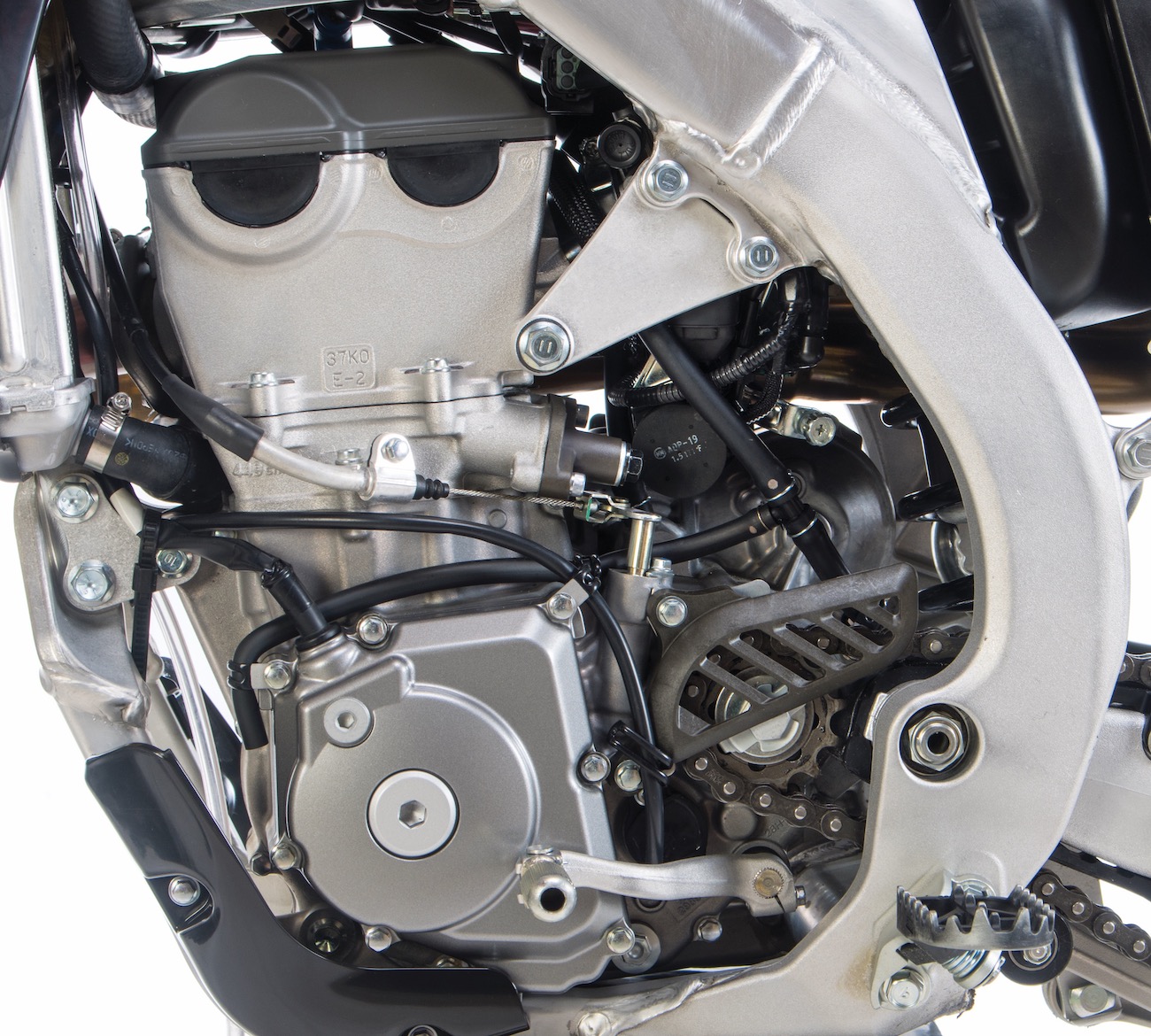
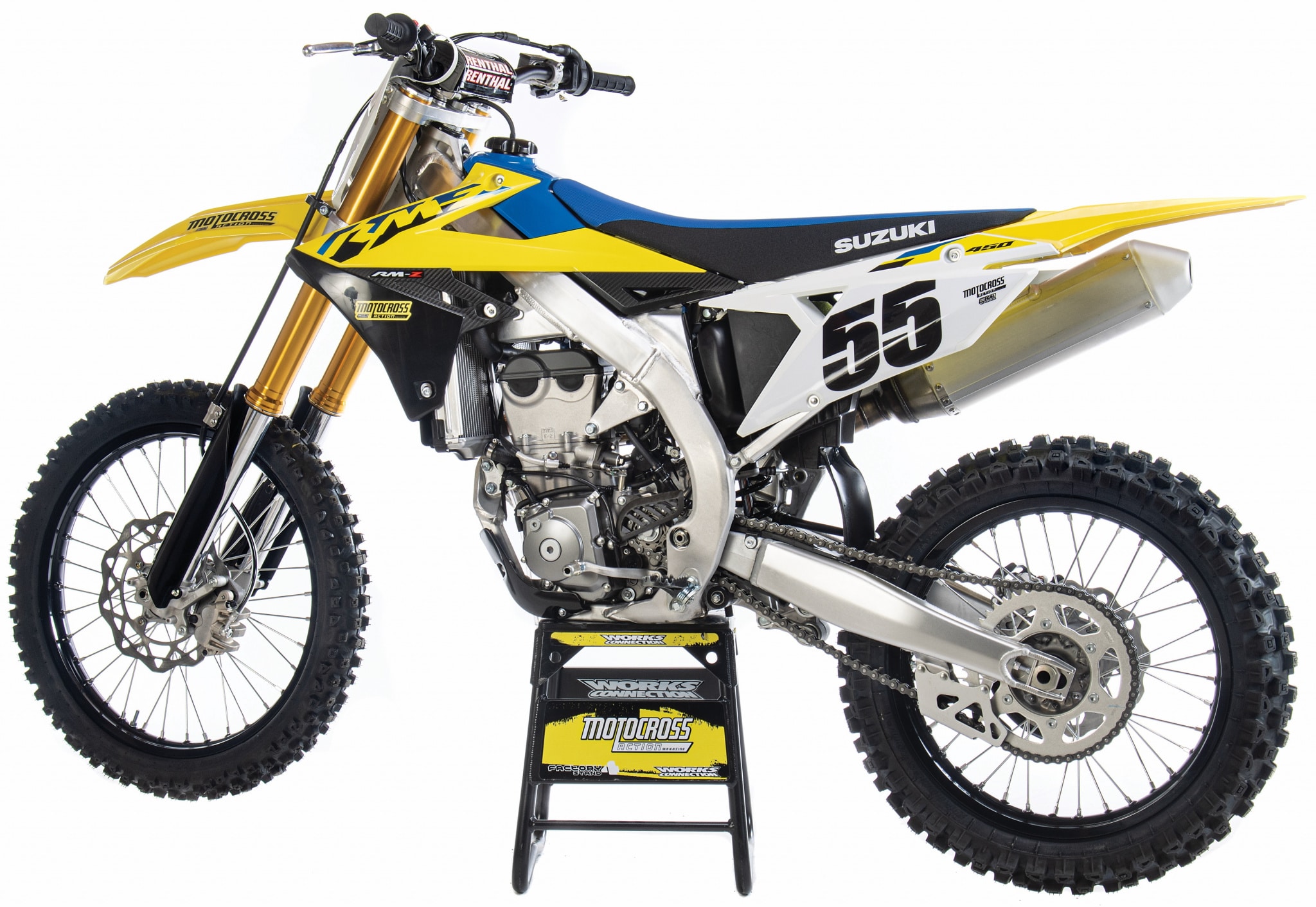
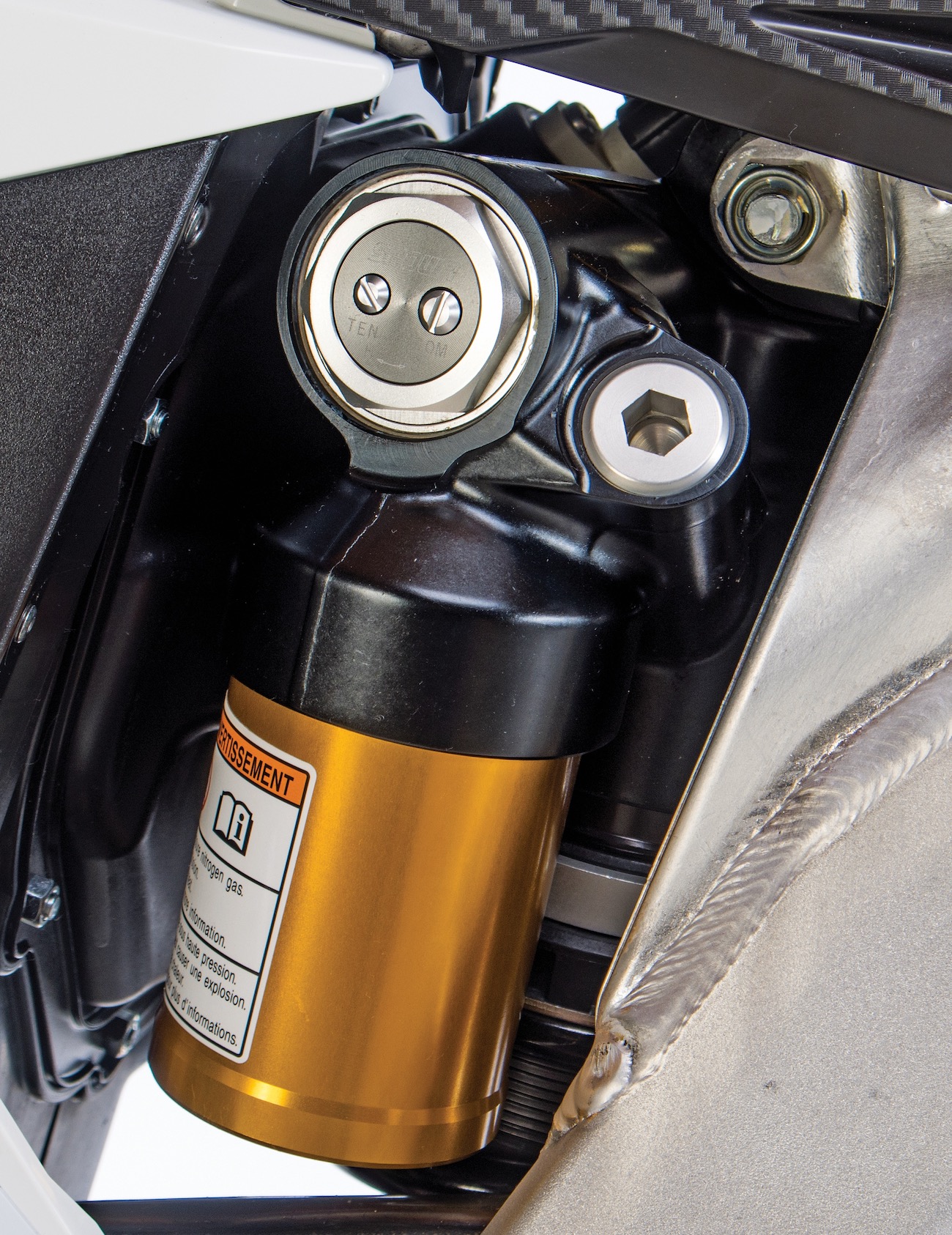

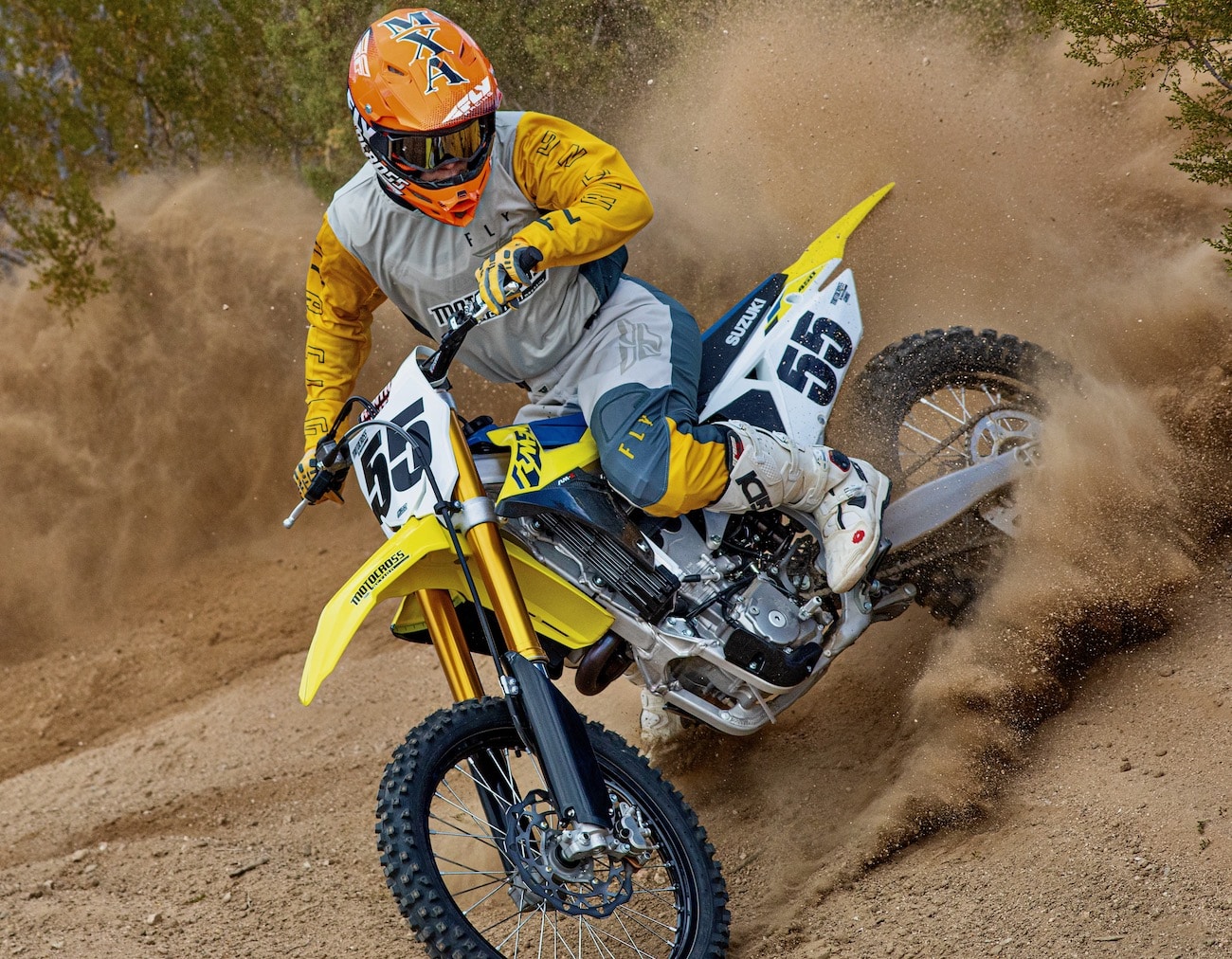
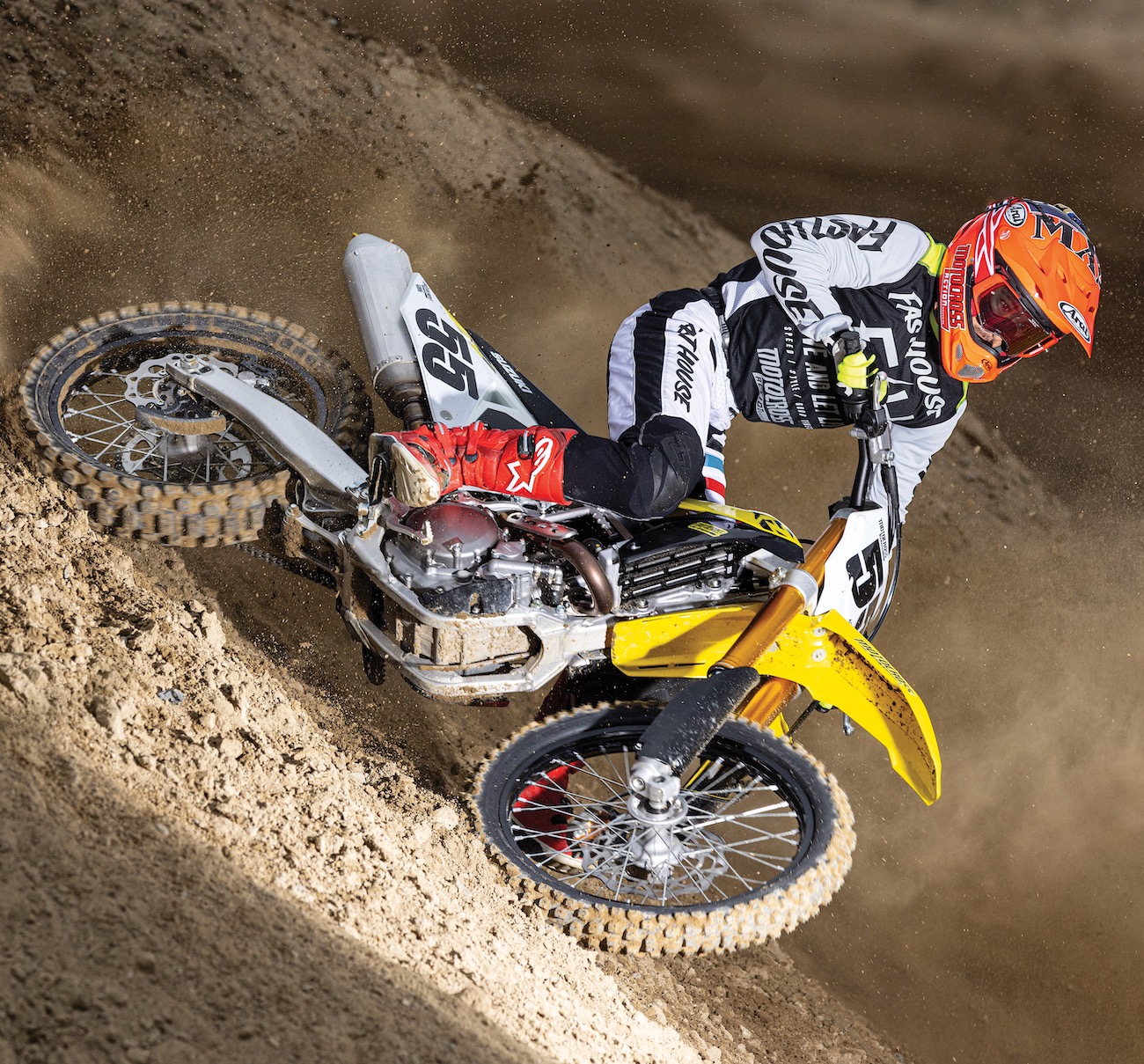



Comments are closed.